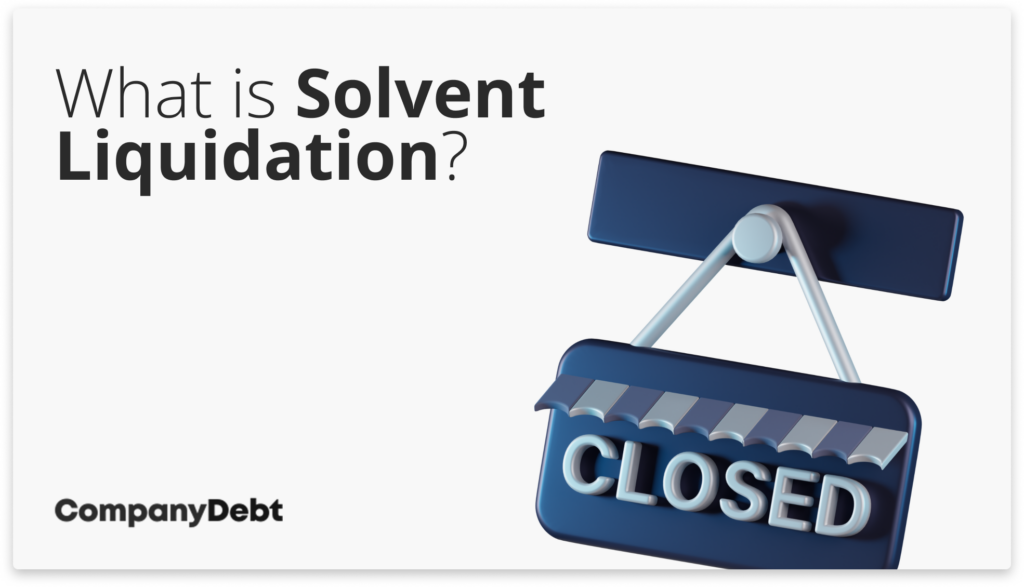
Solvent Liquidation
- What is Solvent Liquidation?
- Can you liquidate a solvent company?
- When is Solvent Liquidation Applicable?
- Solvent vs Insolvent Liquidation
- Advantages of Solvent Liquidation
- Disadvantages of Solvent Liquidation
- What is the Solvent Liquidation Process?
- How Long Does a Solvent Liquidation Take?
- When Closing a Solvent Company, Should I Use an MVL Process or Dissolution?
- How Can Company Debt Help?
What is Solvent Liquidation?
Solvent liquidation is a formal process to close down a company that is financially healthy, meaning it can pay all its debts. This process is usually chosen when a company has served its purpose or the owners wish to retire or move on to new ventures.
It allows the company to end its affairs in an orderly manner, ensuring all debts are paid, and any remaining assets are distributed to shareholders. It’s a tax-efficient way to distribute the company’s assets, typically where assets are £25k or more.

Can you liquidate a solvent company?
Yes, you can liquidate a solvent company; this is typically done through a process called a Members’ Voluntary Liquidation (MVL).
When is Solvent Liquidation Applicable?
Solvent liquidation is suitable for companies where assets exceed liabilities, allowing them to settle all debts within 12 months. This option is ideal for businesses at the end of their lifecycle or when directors decide to cease operations neatly, ensuring no obligations are left unresolved.
Crucially, solvent liquidation becomes particularly tax-efficient when the company’s assets to be distributed exceed £25,000. In such cases, the distributions to shareholders can be treated as capital rather than income, potentially qualifying for lower tax rates, including Business Asset Disposal Relief (formerly known as Entrepreneurs’ Relief), which can significantly reduce capital gains tax liabilities for shareholders.
Solvent vs Insolvent Liquidation
Solvent liquidation, or members’ voluntary liquidation (MVL), is for companies that can pay all their debts and choose to close down voluntarily. It ensures that all creditors are paid in full and any surplus assets are distributed among the shareholders.
Insolvent liquidation, on the other hand, is for companies that cannot pay their debts. This process prioritises paying creditors as much as possible from the company’s remaining assets, often leaving nothing for the shareholders. The key difference lies in the company’s financial health and the outcome for creditors and shareholders.
Advantages of Solvent Liquidation
- Tax Efficiency: Shareholders can receive distributions in a tax-efficient manner, potentially benefiting from tax reliefs such as Entrepreneurs’ Relief, resulting in lower capital gains tax.
- Financial Clarity: Ensures all financial obligations are met, providing clear closure.
- Legal Assurance: Reduces the risk of future claims against directors by ensuring the company’s affairs are concluded properly.
- Structured Closure: Offers a structured and orderly way to close the company.
Disadvantages of Solvent Liquidation
- Cost: The process can be expensive due to legal and professional fees.
- Time-consuming: The procedure requires thorough preparation and can take several months to complete.
- Complexity: Navigating the legal and financial requirements can be complex and may require professional assistance.
What is the Solvent Liquidation Process?
The solvent liquidation process begins with the directors assessing the company’s solvency, ensuring it can pay all debts within 12 months.
Following this, a Declaration of Solvency is prepared, detailing the company’s assets and liabilities. The next step involves calling a shareholders’ meeting to pass a resolution for liquidation and appoint an insolvency practitioner as liquidator.
The liquidator takes control of the company to settle debts, sell assets, and distribute the remaining funds to shareholders. The process is concluded when all affairs are settled, and the company is removed from the Companies House register.
How Long Does a Solvent Liquidation Take?
The duration of a solvent liquidation varies depending on the complexity of the company’s affairs but typically completes within one year.
If the company’s assets are straightforward and readily convertible into cash, and if there are no disputes with creditors, the process can be swift, sometimes concluding in just a few months. However, more complex scenarios, such as selling property or resolving legal issues, can extend the timeline.
The final phase, obtaining tax clearance from HM Revenue & Customs (HMRC), often influences the timeline significantly, as it can take several months for HMRC to review and approve the company’s final tax affairs.
When Closing a Solvent Company, Should I Use an MVL Process or Dissolution?
When deciding to close a solvent company, directors have two main options: a Members’ Voluntary Liquidation (MVL) or applying for dissolution, also known as striking off.
The MVL process is formal, involves appointing an insolvency practitioner, and is more suited for companies with significant assets or complexities. It provides a clear, tax-efficient method for distributing assets to shareholders and ensures all legal obligations are met. Dissolution is simpler and less costly but doesn’t involve the same level of scrutiny or formality.
It’s typically used for companies with minimal assets and liabilities. However, dissolution offers less protection against future claims and less tax efficiency for distributions.
The choice depends on the company’s specific circumstances, including its financial situation, the potential for future claims, and the objectives of its directors and shareholders.
How Can Company Debt Help?
Company Debt provides expert advice and support to directors navigating the complexities of solvent liquidation.
With a focus on ensuring a smooth and compliant process, our team can guide directors through the initial assessment of solvency, preparation of the Declaration of Solvency, and the execution of the liquidation process.
Our expertise includes handling the liquidation’s tax implications, distributing assets efficiently, and concluding the company’s affairs with minimal disruption.







